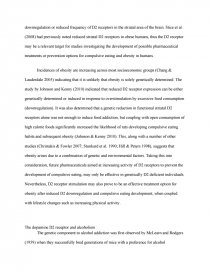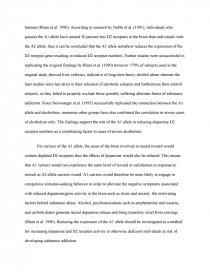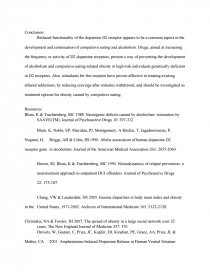The Role of Dopamine and the D2 Receptor in the Dysfunction of Neural Mechanisms
Essay by nourah • March 25, 2013 • Research Paper • 2,117 Words (9 Pages) • 1,404 Views
Essay Preview: The Role of Dopamine and the D2 Receptor in the Dysfunction of Neural Mechanisms
Abstract
Substance addiction is a major economic, social and personal problem. The role of dopamine in establishing neural reinforcement for substance abuse has been noted extensively over past decades. The D2 dopamine receptor is being implicated more and more frequently in studies as having a major role in substance addiction. This review aims to investigate the role of dopamine and the D2 receptor in driving food and alcohol addiction. It was found that the A1 allele of the dopamine D2 receptor gene is heritable factor responsible for reduced D2 expression resulting in a predisposition for developing food addiction or alcoholism with environmental influences. This indicates that future studies investigating the development of drugs that target and stimulate D2 receptors, thereby increasing dopamine activity, may be valuable for treating or even preventing compulsive eating-related obesity and alcoholism.
Keywords
Addiction, obesity, ethanol, A1 allele, downregulation.
Introduction
It is well established that dopamine plays a key role in generating neural reward memory in the mammalian brain by eliciting positive neural effects in response to certain stimuli (Drevets et al. 2001). Dopamine acts on five distinctive receptors (D1, D2, D3, D4 and D5) located on the synaptic membranes of neurons in areas of the brain involved in neural reward memory to induce this effect (Tisch et al. 2004; Drevets et al. 2001). Over the past few decades, dysfunction of these receptors has been identified as a major contributor to the development of various reward deficiency conditions such as substance addiction (Volkow et al. 1996; Wang et al. 1997). Addiction is classified as the repeated and uncontrolled behaviour to seek and consume a substance despite acknowledged negative consequences (Edwards 1981).
This literature review will focus on the role of the D2 dopamine receptor in compulsive eating and alcohol consumption. Both of these forms of substance addiction are prevalent in today's society and have extensive detrimental social, economic and personal health costs. For this reason, understanding the neural mechanisms underlying addiction may result in effective treatment or prevention opportunities in the future.
The mesolimbic neural pathway is recognised as a major dopaminergenic neural pathway involved in the process of forming reward memory (Tisch et al. 2004). Mesolimbic neurones extend from the ventral tegmental area of the midbrain to various other areas of the brain, notably the nucleus accumbens: a primary neural reward response area (Tisch et al. 2004). Mesolimbic neurons release dopamine in response to various stimuli, including certain foods (Johnson & Kenny 2010), sexual arousal (Giuliano & Allard 2001) and various drugs (L'Aurelle et al. 2005). The resulting positive neural reward induces conditioning of the stimulus to become associated with the positive effects of dopamine and relief from the dysphoric symptoms of low dopamine activity, which include stress and anxiety. This review will investigate genetic deficiency or stimulus-induced downregulation of the D2 dopamine receptor in development and maintenance of food and alcohol addiction.
The dopamine D2 receptor and compulsive eating
With the increasing prevalence of obesity in many societies over recent years (Chang & Lauderdale 2005; Hedley et al. 2004) and the associated detrimental health conditions, the need to understand the biological and neural mechanisms behind pathological overeating is becoming more urgent. Johnson and Kenny (2010) recently identified the role of the dopamine D2 receptor in rats addicted to highly palatable and energy rich foods. The study (Johnson & Kenny 2010) indicated a positive correlation between the emergence of compulsive eating in rats and the deterioration of neural reward responses, which was subsequently shown to be linked to downregulation or reduced frequency of D2 receptors in the striatal area of the brain. Stice et al. (2008) had previously noted reduced striatal D2 receptors in obese humans, thus the D2 receptor may be a relevant target for studies investigating the development of possible pharmaceutical treatments or prevention options for compulsive eating and obesity in humans.
Incidences of obesity are increasing across most socioeconomic groups (Chang & Lauderdale 2005) indicating that it is unlikely that obesity is solely genetically determined. The study by Johnson and Kenny (2010) indicated that reduced D2 receptor expression can be either genetically determined or induced in response to overstimulation by excessive food consumption (downregulation). It was also determined that a genetic reduction in functional striatal D2 receptors alone was not enough to induce food addiction, but coupling with open consumption of high calorie foods significantly increased the likelihood of rats developing compulsive eating habits and subsequent obesity (Johnson & Kenny 2010). This, along with a number of other studies (Christakis & Fowler 2007; Stunkard et al. 1990; Hill & Peters 1998), suggests that obesity arises due to a combination of genetic and environmental factors. Taking this into consideration, future pharmaceuticals aimed at increasing activity of D2 receptors to prevent the development of compulsive eating, may only be effective in genetically D2 deficient individuals. Nevertheless, D2 receptor stimulation may also prove to be an effective treatment option for obesity after induced D2 downregulation and compulsive eating development, when coupled with lifestyle changes such as increasing physical activity.
The dopamine D2 receptor and alcoholism
The genetic component to alcohol addiction was first observed by McLearn and Rodgers (1959) when they successfully bred generations of mice with a preference for alcohol consumption over water. Since then, alcoholism has been linked to reduced dopamine and D2 receptor activity by a number of studies, for example; rats bred to exhibit alcohol preference show reduced release of dopamine into the nucleus accumbens and reduced frequency of D2 receptors on neurons in certain areas of the limbic system (Russell et al. 1988; McBride et al. 1993). Studies involving humans have reported similar results in alcoholics (Volkow et al. 1996). In addition, individuals with a family history of alcohol dependence but who have higher D2 receptor levels are less likely to develop alcoholism (Volkow et al. 2006).
McBride et al. (1993) investigated further the role of the D2 receptor in alcoholism and found that administering alcoholic rats with an agonist
...
...







